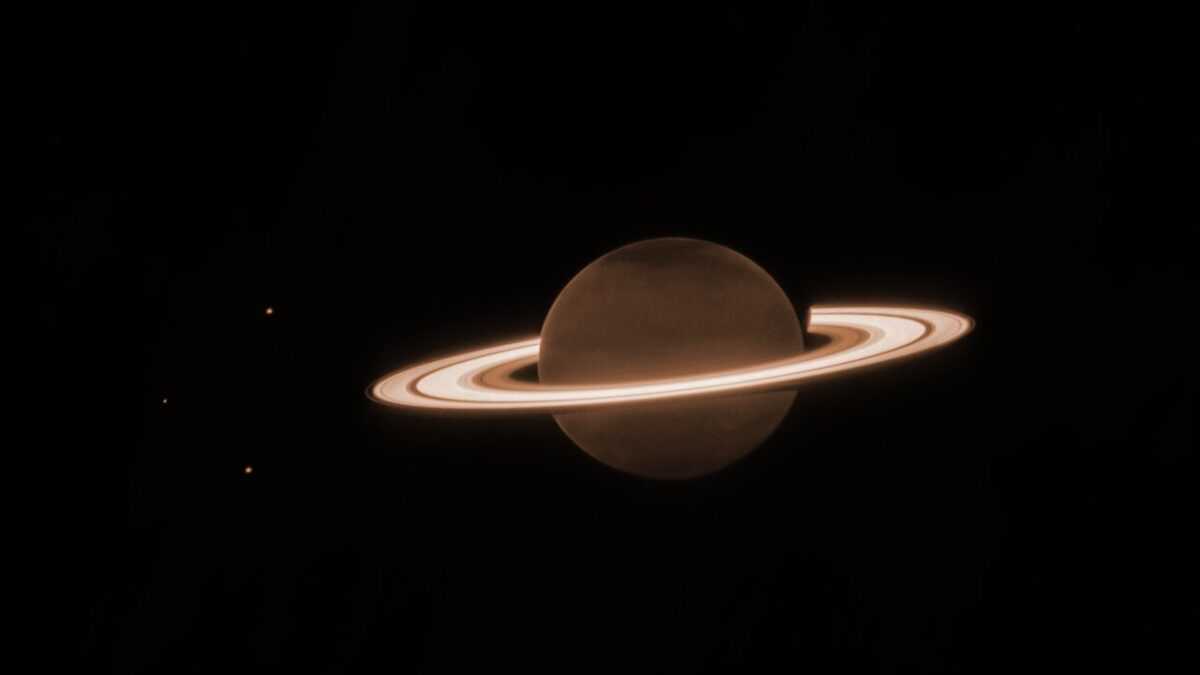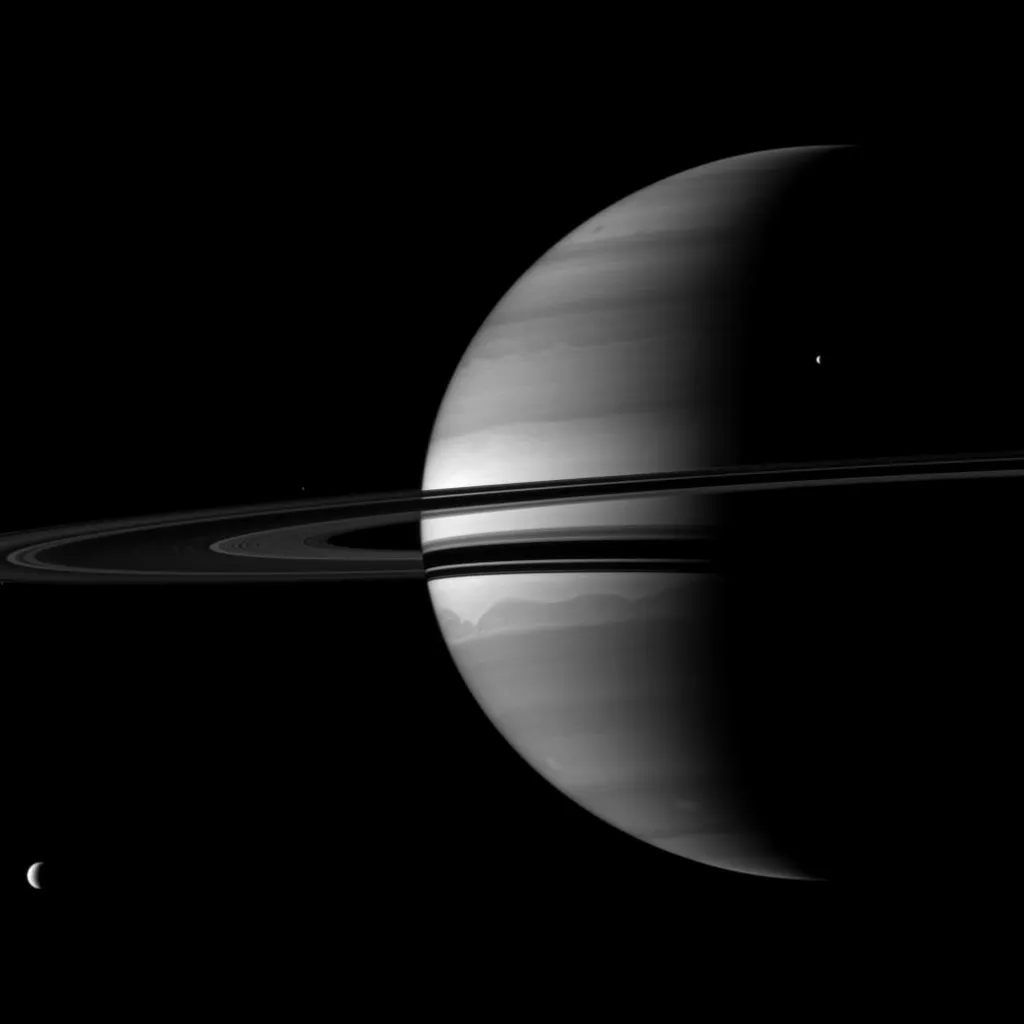Μια νέα εικόνα από το καμάρι των NASA/ESA/CSA, το James Webb Space Telescope μας αφήνει άφωνους. Είναι η πρώτη near-infrared εικόνα παρατήρησης του πλανήτη και βλέπουμε τις λεπτομέρειες από το σύστημα των δαχτυλιδιών αλλά…
…και πολλά από τα φεγγάρια του Κρόνου όπως τη Διώνη, τον Εγκέλαδο. Η εικόνα ελήφθη στις 25 Ιουνίου 2023 και έρχεται από την Webb Near-Infrared Camera (NIRCam).
Το τελευταίο διάστημα βέβαια αστρονόμοι ταυτοποίησαν άλλους 62 δορυφόρους γύρω από τον Κρόνο και έτσι φτάνουμε σε 145 φεγγάρια σε τροχιά γύρω από αυτόν τον αέριο γίγαντα του πλανητικού μας συστήματος.
Ο Κρόνος, αυτός ο Λεβιάθαν του διαστήματος που βρίσκεται σε απόσταση 1.3 δισεκατομμύρια χιλιόμετρα από τη Γη, είναι έτσι πιο ισχυρός από τον Δία σε αυτόν τον τομέα αφού έχουν καταγραφεί 92 ουράνια σώματα που περιστρέφονται γύρω από τον συγκεκριμένο πλανήτη χωρίς όμως να ξέρουμε τι θα δώσουν και οι μελλοντικές μελέτες μετά από τα στοιχεία που μας έρχονται από διαστημικά τηλεσκόπια αλλά και επίγεια.
(Εικόνα: NASA/JPL/Space Science Institute)
Τα νέα φεγγάρια του Κρόνου εντοπίστηκαν από μια ομάδα επιστημόνων με επικεφαλής τον Έντουαρντ Άστον, μεταδιδακτορικό ερευνητή του Ινστιτούτου Αστρονομίας και Αστροφυσικής της Σινικής Ακαδημίας της Ταϊβάν. Χρειάστηκαν πάνω από δύο χρόνια για να ταυτοποιηθούν τόσα ουράνια σώματα, μετά από την ανάλυση των δεδομένων που προέρχονται από τις παρατηρήσεις του τηλεσκοπίου στην κορυφή του όρους Μάουνα Κέα, στη Χαβάη όπως έγραψε το BBC.
Astronomers using the @CFHTelescope announced the discovery last month of an additional 62 moons orbiting around Saturn, bringing the planet's total to 145 moons. Led by Edward Ashton, the team unveiled moons down to a size of 2.5km or 1.5 miles. pic.twitter.com/aIgm7xbOf6
— Maunakea Observatories (@maunakeaobs) June 23, 2023
Τι μετρά ως φεγγάρι;
Moon’s are natural satellites – usually solid, rocky bodies – that orbit larger objects such as planets. The “traditional” moons are found orbiting the planets of the Solar System (and the dwarf planet Pluto). But astronomers have documented more than 460 moons orbiting asteroids and other objects such as those found in the Kuiper Belt, the ring of icy material that sits out beyond Neptune. Scientists have also discovered much smaller “moonlets” orbiting in Saturn’s rings – although some can be as large as a football stadium – and are thought to be the remains of larger moons that were smashed to pieces in the past.
—–
On 25 June 2023, the NASA/ESA/CSA James Webb Space Telescope turned to famed ringed world Saturn for its first near-infrared observations of the planet. The initial imagery from Webb’s NIRCam (Near-Infrared Camera) is already fascinating researchers.
Saturn itself appears extremely dark at this infrared wavelength observed by the telescope, as methane gas absorbs almost all of the sunlight falling on the atmosphere. However, the icy rings stay relatively bright, leading to the unusual appearance of Saturn in the Webb image.
This image was taken as part of Webb Guaranteed Time Observation program 1247. The program included several very deep exposures of Saturn, which were designed to test the telescope’s capacity to detect faint moons around the planet and its bright rings. Details in the orbital characteristics of newly discovered moons could help scientists put together a more complete picture of the current system of Saturn, as well as its past.
This new image of Saturn clearly shows details within the planet’s ring system, along with several of the planet’s moons – Dione, Enceladus, and Tethys. Additional deeper exposures (not shown here) will allow the team to probe some of the planet’s fainter rings, not visible in this image, including the thin G ring and the diffuse E ring. Saturn’s rings are made up of an array of rocky and icy fragments – the particles range in size from smaller than a grain of sand to a few as large as mountains on Earth. Researchers recently used Webb to explore Enceladus, and found a large plume jetting from the southern pole of the moon that contains both particles and plentiful amounts of water vapor – this plume feeds Saturn’s E ring.
Saturn’s atmosphere also shows surprising and unexpected detail. This is the first time that the planet’s atmosphere has been seen with such clarity at this particular wavelength (3.23 microns). The large, dark, diffuse structures in the northern hemisphere do not follow the planet’s lines of latitude, so this image is lacking the familiar striped appearance that is typically seen from Saturn’s deeper atmospheric layers. The patchiness is reminiscent of large-scale planetary waves in the stratospheric aerosols high above the main clouds, potentially similar to those seen in early Webb NIRCam observations of Jupiter.
When comparing the northern and southern poles of the planet in this image, the differences in appearance are typical with known seasonal changes on Saturn. For example, Saturn is currently experiencing northern summertime, with the southern hemisphere emerging from the darkness at the end of a winter. However, the northern pole is particularly dark, perhaps due to an unknown seasonal process affecting polar aerosols in particular. A tiny hint of brightening towards the edge of Saturn’s disk might be due to high-altitude methane fluorescence (the process of emitting light after absorbing light), emission from the trihydrogen ion (H3+) in the ionosphere, or both; spectroscopy from Webb could help confirm this.
Missions like NASA’s Pioneer 11, Voyagers 1 and 2, the Cassini spacecraft, and the NASA/ESA Hubble Space Telescope have tracked Saturn’s atmosphere and rings for many decades. These observations from Webb are just a hint at what this observatory will add to Saturn’s story in the coming years as the science team delves deep into the data to prepare peer-reviewed results.
Note: This content highlights data from Webb science in progress, which has not yet been through the peer-review process.
[Image description: Image has a mostly dark background and at the center is a dark orange brownish circle, surrounded by several blazing bright, thick, horizontal whiteish rings. This is Saturn and its rings. There are three tiny orange dots in the image — one to the upper left of the planet, one to the direct left of the planet, and the lower left of the planet. They are the moons Dione, Enceladus, and Tethys.]
Credit:
NASA, ESA, CSA, STScI, M. Tiscareno (SETI Institute), M. Hedman (University of Idaho), M. El Moutamid (Cornell University), M. Showalter (SETI Institute), L. Fletcher (University of Leicester), H. Hammel (AURA), J. DePasquale (STScI)
Related posts
Categories
- android World
- cinemart / music / video
- comicmania / books
- computing / social media
- consumer electronics
- design / architecture
- ecotech / electric
- exhibitions
- faq / Infographics
- futuristas / iDea
- gadgetfreak taste
- gadgets / stuff
- gaming / fun
- iOS World
- legends / special
- men's world
- military / aviation
- mobile / smartphones
- space talk
- tablets / multimedia
- tech talk / science
- transport / concept




